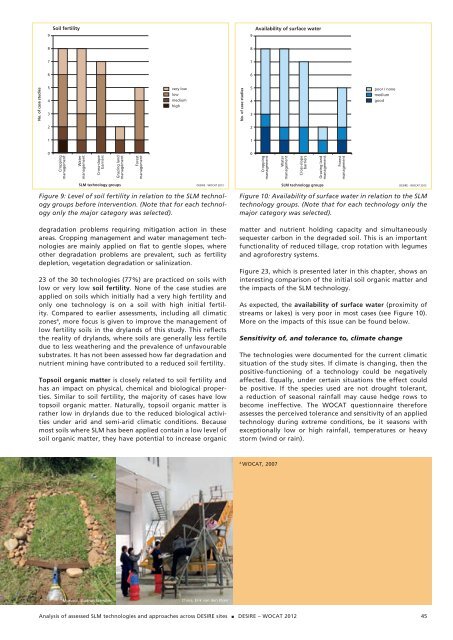Desire for Greener Land
Desire for Greener Land
Desire for Greener Land
Create successful ePaper yourself
Turn your PDF publications into a flip-book with our unique Google optimized e-Paper software.
No. of case studies<br />
Soil fertility<br />
9<br />
8<br />
7<br />
6<br />
5<br />
4<br />
3<br />
2<br />
1<br />
0<br />
Cropping<br />
management<br />
Water<br />
management<br />
Cross-slope<br />
barriers<br />
Grazing land<br />
management<br />
SLM technology groups<br />
very low<br />
low<br />
medium<br />
high<br />
degradation problems requiring mitigation action in these<br />
areas. Cropping management and water management technologies<br />
are mainly applied on flat to gentle slopes, where<br />
other degradation problems are prevalent, such as fertility<br />
depletion, vegetation degradation or salinization.<br />
23 of the 30 technologies (77%) are practiced on soils with<br />
low or very low soil fertility. None of the case studies are<br />
applied on soils which initially had a very high fertility and<br />
only one technology is on a soil with high initial fertility.<br />
Compared to earlier assessments, including all climatic<br />
zones 4 , more focus is given to improve the management of<br />
low fertility soils in the drylands of this study. This reflects<br />
the reality of drylands, where soils are generally less fertile<br />
due to less weathering and the prevalence of unfavourable<br />
substrates. It has not been assessed how far degradation and<br />
nutrient mining have contributed to a reduced soil fertility.<br />
Topsoil organic matter is closely related to soil fertility and<br />
has an impact on physical, chemical and biological properties.<br />
Similar to soil fertility, the majority of cases have low<br />
topsoil organic matter. Naturally, topsoil organic matter is<br />
rather low in drylands due to the reduced biological activities<br />
under arid and semi-arid climatic conditions. Because<br />
most soils where SLM has been applied contain a low level of<br />
soil organic matter, they have potential to increase organic<br />
Forest<br />
management<br />
DESIRE - WOCAT 2012<br />
Figure 9: Level of soil fertility in relation to the SLM technology<br />
groups be<strong>for</strong>e intervention. (Note that <strong>for</strong> each technology<br />
only the major category was selected).<br />
Morocco, Gudrun Schwilch<br />
China, Erik van den Elsen<br />
Availability of surface water<br />
9<br />
Cropping<br />
management<br />
matter and nutrient holding capacity and simultaneously<br />
sequester carbon in the degraded soil. This is an important<br />
functionality of reduced tillage, crop rotation with legumes<br />
and agro<strong>for</strong>estry systems.<br />
Figure 23, which is presented later in this chapter, shows an<br />
interesting comparison of the initial soil organic matter and<br />
the impacts of the SLM technology.<br />
As expected, the availability of surface water (proximity of<br />
streams or lakes) is very poor in most cases (see Figure 10).<br />
More on the impacts of this issue can be found below.<br />
Sensitivity of, and tolerance to, climate change<br />
The technologies were documented <strong>for</strong> the current climatic<br />
situation of the study sites. If climate is changing, then the<br />
positive-functioning of a technology could be negatively<br />
affected. Equally, under certain situations the effect could<br />
be positive. If the species used are not drought tolerant,<br />
a reduction of seasonal rainfall may cause hedge rows to<br />
become ineffective. The WOCAT questionnaire there<strong>for</strong>e<br />
assesses the perceived tolerance and sensitivity of an applied<br />
technology during extreme conditions, be it seasons with<br />
exceptionally low or high rainfall, temperatures or heavy<br />
storm (wind or rain).<br />
4 WOCAT, 2007<br />
Analysis of assessed SLM technologies and approaches across DESIRE sites DESIRE – WOCAT 2012<br />
No. of case studies<br />
8<br />
7<br />
6<br />
5<br />
4<br />
3<br />
2<br />
1<br />
0<br />
Water<br />
management<br />
Cross-slope<br />
barriers<br />
Grazing land<br />
management<br />
SLM technology groups<br />
Forest<br />
management<br />
poor / none<br />
medium<br />
good<br />
DESIRE - WOCAT 2012<br />
Figure 10: Availability of surface water in relation to the SLM<br />
technology groups. (Note that <strong>for</strong> each technology only the<br />
major category was selected).<br />
45









